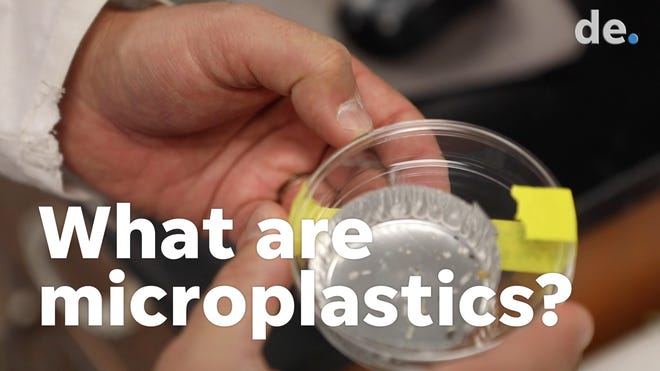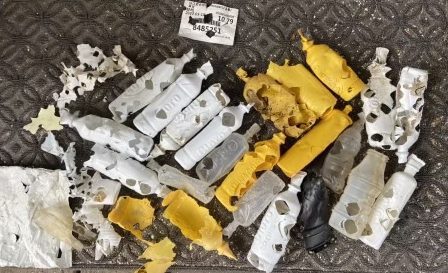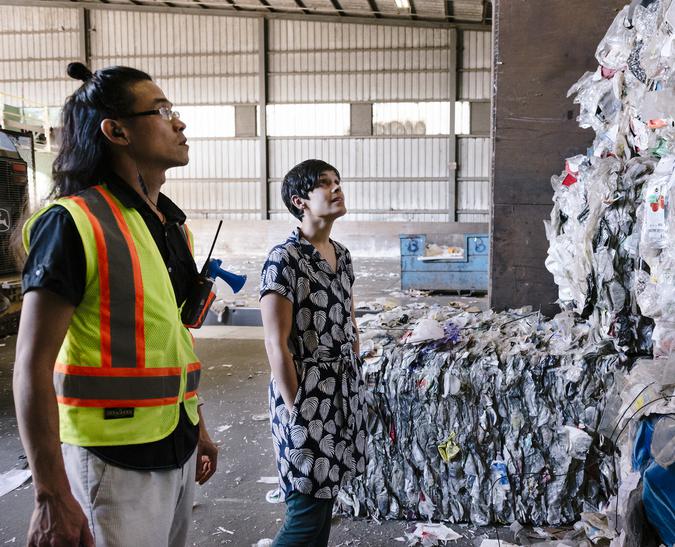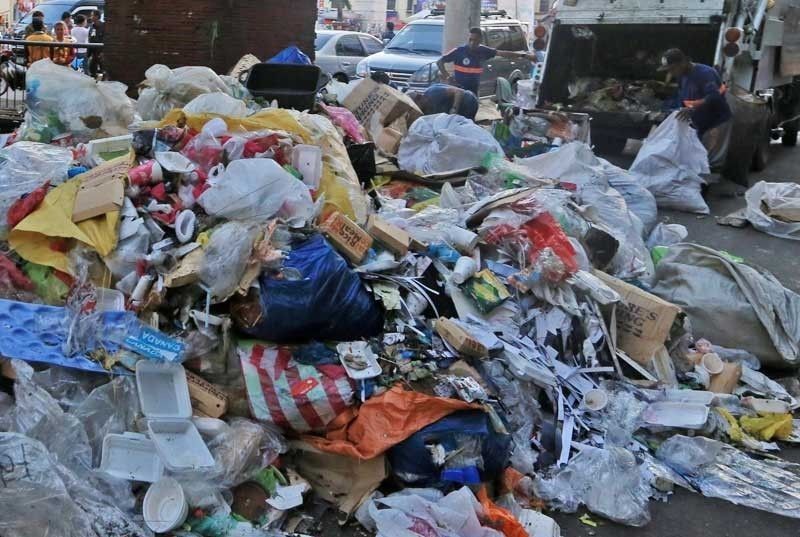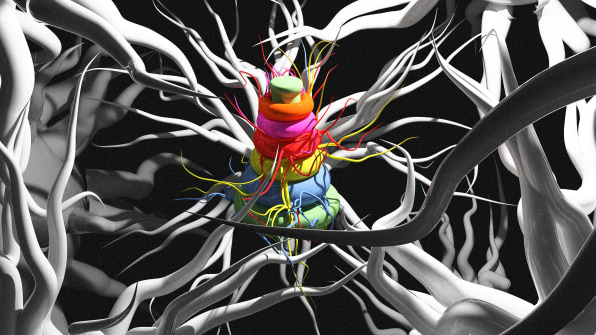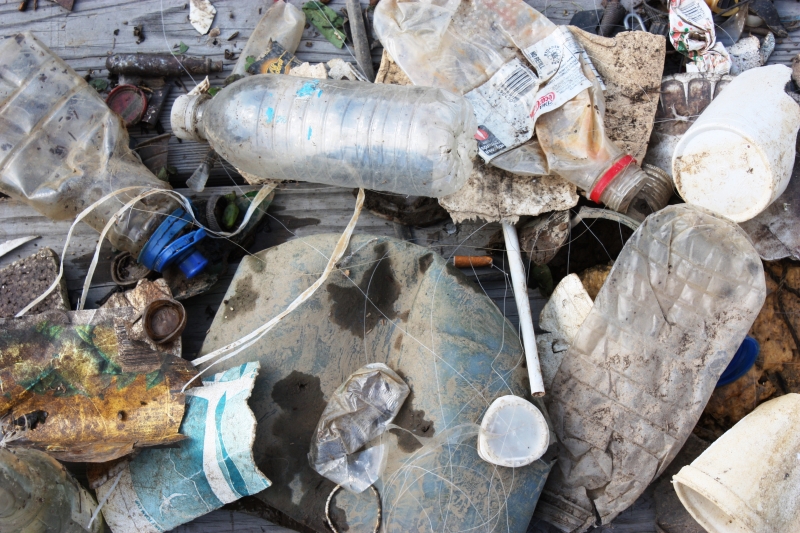NEW BEDFORD — Walk by a salt marsh and you’ll see tall grasses, a glassy water surface and perhaps a few local bird species. By sight alone, the marsh may appear to be in its natural state.According to a new study, though, some marshes — built up for years and years by layers of sediment — contain countless plastic fragments and fibers under their surfaces, some so tiny they’re only visible through a microscope. Javier Lloret, a research scientist at the Marine Biological Laboratory in Woods Hole and a lead author, said the study is the first step in considering what implications microplastics have for salt marshes. “Humans are the ones producing these plastics that ultimately will break up into little tiny pieces, become microplastics and contaminate our environment,” Lloret said. “So one of the hypotheses that we started with was the idea of, if you have more people living in an area, if the area is more densely urbanized, the salt marshes in that area are going to have more microplastics in the sediment. It makes total sense from a common sense point of view, but it had not been tested yet.”And that’s what they found: the more urbanized the surrounding land was, the more microplastic fragments they found in the salt marsh sediment.For the study, researchers took sediment cores from salt marshes in Cape Cod and New Bedford. Each marsh had a different level of watershed development and population density, with the New Bedford site being the most urbanized. Keeping the environment clean:Volunteers collect trash in Fairhaven. Next, they’ll mail some back to the companies.While they found microplastic fragments and fibers in all sampling sites, they found a link between the number of fragments and level of urbanization. Specifically, the abundance of microplastic fragments in sediment samples increased as the degree of urban development on adjoining land increased.What was consistent across sites, though, was the amount of microplastic fibers — the material released from synthetic clothing or fishing gear. Regardless of the level of urbanization, fibers were equally abundant in the samples, Lloret said.Due to this distinction, Lloret believes fragments have a local source, whereas fibers may be sourced from the region as they can be transported more easily by wind or water. Reconstructing the history of microplasticsAt two of the Cape Cod sites, the scientists took deeper sediment cores to trace when plastic started appearing in the salt marsh. About 30 centimeters deep took them to the early 1940s, Lloret said, when plastic was rare and not widely used. While studying the cores, they found the number of microplastics increased dramatically closer to the surface.Salt marsh restoration:Climate change creates stress for homeowners battling erosion on Cape Cod”In the last 25 years, the number of [plastic] particles you find in the sediments was doubled,” he said. “If we continue these trends, in just a matter of another decade we can have a lot more microplastics, and the impacts that we’re still trying to figure out can be even worse.” What does this mean for salt marshes?Salt marshes are important ecosystems. They provide habitats for numerous species (including shellfish some people enjoy eating), protect coastlines against storm surges and sea level rise, and sequester carbon, Lloret said. They also act as effective “sinks,” with the grasses capturing materials — be it plant matter, dirt or plastic — and depositing it on the base of the marsh.’Drowning in place’: Mass Audubon begins work to protect Dartmouth salt marshLloret said this study was just the first step. It confirmed salt marshes contain microplastics and that levels are linked to human activity. However, the “million dollar question” that remains is what the presence of microplastics means for the health and functionality of the ecosystem. Filter feeders like mussels and clams don’t differentiate between a particle of food or a microplastic, Lloret said. If they consume plastic, it can affect their health as well as that of human consumers. “I’m very interested in the effects that it’s going to have in the food web, because those food webs are responsible for the functioning of the entire ecosystem,” he said. “That’s the kind of direction that I would like to go with this.” Until he and other researchers untangle those big questions, Lloret said municipalities and the state can consider actions, such as educating residents on recycling or establishing regulations that bar certain synthetic materials. The bottom line, though, is trying to use less things that are made of plastic, he said. Standard-Times reporter Anastasia E. Lennon can be reached at alennon@s-t.com. You can follow her on Twitter at @aelennon1. Support local journalism by purchasing a digital or print subscription to The Standard-Times today.
Category Archives: News
Plastic recycling could be more dangerous than you think
Efforts to end plastic pollution with recycling could leave people and the environment laden with poisonous chemicals, a new study has found. The report, which was not peer-reviewed, assessed four recycling and plastic waste management techniques that are poised to become more common as countries, including Canada, try to reduce plastic pollution. It found the main solutions promoted by the plastic industry — recycling, incineration, and transforming plastic into fuel — will increase people’s risk of exposure to a cocktail of toxic chemicals. Most plastic products contain toxic chemicals added to give plastic desirable traits, like flexibility or non-stick properties. When they are broken down during recycling or incineration, these toxins — everything from endocrine disrupters to cancer-causing chemicals — can escape recycling facilities and landfills to contaminate people and the environmentGet top stories in your inbox.Our award-winning journalists bring you the news that impacts you, Canada, and the world. Don’t miss out.“It doesn’t matter which of those methods you choose. The toxic additives in plastic are creating exposure to the point where it’s a detriment to human health,” said Lee Bell, report co-author and policy adviser on persistent organic pollutants to the International Pollutant Elimination Network (IPEN), an international coalition of environmental organizations that produced the study. That problem is exacerbated by recycling and other waste management techniques. For instance, chemical recycling — a suite of processes that break plastic down into its molecular components to make new products — produces a sludge of concentrated toxins. Techniques that transform plastic into fuel or to burn it to produce heat or electricity have similar issues, the report notes. The sludge or ash produced during these processes is typically put in landfills, used in landscaping or road construction, or spewed directly into the environment. Bell explained that, over time, these toxins end up leaching into the environment and contaminating soil, water, and the food chain. What people are reading Mechanical recycling — a common technique where old plastic is shredded and melted into new products — also concentrates toxic additives in the new products. Beyond the dangers the final products present to human health, the technique is expensive and struggles to compete with new plastics, Bell said. The problem is poised to get exponentially worse, with oil and gas companies anticipating that plastic production will make up the bulk of their future growth as the world transitions away from fossil fuels. Annual global plastic production is expected to more than quadruple in the next 30 years to reach 1.8 billion tonnes in 2050, according to the report. “That production schedule will swamp any attempts to deal with (plastic waste) from a recycling perspective,” Bell said. “The only way you can try to bring that into some sort of equilibrium is to try and cap production.”Yet countries have been reluctant to curb production.For instance, earlier this year, Canada listed plastic as toxic under its primary environmental law. The move was the first step in the federal government’s proposed plan to end plastic waste. Under the proposal, some single-use items would be banned and other restrictions implemented to boost Canada’s recycling capacity roughly six-fold by 2030. Efforts to end plastic pollution with recycling could leave people — and the environment — laden with poisonous chemicals, a new study has found. #Plastics Only about nine per cent of Canada’s plastic is recycled, mostly using mechanical recycling, according to a 2019 study commissioned by Environment and Climate Change Canada (ECCC). The remainder goes to landfills, is incinerated, or leaks into the environment. However, despite the decision to list plastic as toxic, the Trudeau government has yet to limit plastic production. “(ECCC) is working…to implement a comprehensive agenda for zero plastic waste by 2030. We are also taking action to develop recycled content standards and to hold producers responsible for their plastic waste. This approach seeks to transition Canada away from a linear economy that disposes of plastic as waste, and towards a circular economy that keeps plastic in the economy and out of the environment… Proposed regulations to prohibit or restrict certain harmful single-use plastics will be published for public comment later this year,” said Moira Kelly, press secretary to Environment Minister Jonathan Wilkinson, in a statement.“Unless we have a global treaty that limits plastic production in the same way the Paris Agreement seeks to limit carbon emissions, we are not going to be able to come up with a circular economy,” Bell noted. In a circular economy, plastic couldn’t contain toxic additives to make it more easily recyclable. It would also need to be limited to medical devices and other essential uses. “I don’t think it’s that far away, but we’re being held up by the petrochemical and fossil fuel companies from reaching that point,” he said. “The one thing they don’t want to hear is limits on production because if they can’t use (oil) as fuel and they can’t pump it into plastics production, they’ve got a problem.”
Increasing plastic pollution harming sea turtles along the Gulf Coast
Increasing plastic pollution harming sea turtles along the Gulf Coast | WKRG Skip to content ✕ × Close Ad
West Coast cleanup nets over 200 tonnes of marine debris
For weeks at a time, crews have been scouring remote sections of the West Coast — digging out massive fishing nets, hauling lines, tossing thousand of buoys and shifting mountains of Styrofoam to try to make a dent in the ocean refuse finding its way onto B.C.’s wildest shores. A shocking 210 tonnes of flotsam and plastic detritus was removed over six weeks from a mere 300 kilometres of the province’s intricate 25,000-kilometre shoreline during this year’s massive cleanup of the ecologically sensitive foreshores of the Great Bear Rainforest. “It’s just perpetual. It just keeps washing ashore,” said Scott Benton, executive director of the Wilderness Tourism Association. Get top stories in your inbox.Our award-winning journalists bring you the news that impacts you, Canada, and the world. Don’t miss out.“It’s a huge volume of garbage. And a very small portion of the coast when you consider how many kilometres of coastline there is in B.C.” The industrial-scale effort involved a fleet of nine small-ship ecotourism vessels crewed by 150 people who would have otherwise been out of work this May and June due to COVID-19 travel restrictions, Benton said. The undertaking also required an immense barge, a helicopter, a contingent of small boats and partnerships with the Kitasoo/Xai’xais, Gitga’at, Haisla, and Gitxaala nations. What people are reading Wilderness tourism staff collected fishing nets, thousands of buoys and mountains of Styrofoam to try to make a dent in the ocean refuse finding its way onto B.C.’s wildest shores. Photo Jeff ReynoldsBut the results speak for themselves as the enterprise, benefiting from previous experience, managed to almost double the 127 tonnes of trash picked up last spring during the inaugural launch of the provincial initiative, Benton said. In April, the province backed the initiative again, divvying up $9.5 million from the Clean Coast, Clean Waters Fund to four groups or associations in an effort to remove garbage from 1,200 kilometres of shore, or more than 100 derelict vessels along the north coast down to southern Vancouver Island. In addition to providing pandemic relief to the embattled wilderness tourism sector, the project was a response to the call for action around marine debris from coastal communities, said Environment Minister George Heyman. “It can feel like you’re putting a Band-Aid on an artery,” says Quadra Islander Breanne Quesnel on collecting marine debris. “But we live in this this beautiful place, and you just want to do what what you can to help, rather than hurt it.” Local governments and resident complaints involved derelict vessels, mooring buoys, polystyrene foam, aquaculture and fishing debris, and single-use plastics, he added. “The scale of the problem is massive, and we need to do much more to address ocean debris and its devastating impacts on marine life and food sources,” Heyman said. The vast majority of the ocean trash being removed from B.C.’s pristine shores is plastic, said Jeff Reynolds, a biologist and guide with Maple Leaf Adventures, who has been involved in the cleanup both years. Each year, globally, about eight million tonnes of plastic waste enters oceans. This translates to the dumping of a garbage truck of plastic into the sea every single minute. “It’s not just local, the debris is from all over the world,” Reynolds said.The gruelling work to collect it involved scrambling over rough terrain and tangled masses of driftwood to shift, pile, and sort garbage before loading it onto boats headed for the barge, or for pick up by helicopter directly from the beach. By weight, 50 per cent of what he and his crew mates wrestled from the shores exposed to the Pacific was nylon fishing nets or lines, Reynolds said. In terms of volume, crumbling foam from docks or floats, along with plastic buoys or floats, were the most common offenders. And then there were the ubiquitous plastic bottles. The team likely picked up around 90,000 of them, he said. Reynolds was heartened that this year rather than just dumping the debris in landfills, roughly 60 per cent of it was sorted for recycling. And despite the labour involved, the effort was worth more than just getting a paycheque during the pandemic, he said. “We all really care for this coast,” he said. “And there’s been a real incredible response, and I’ve enjoyed being part of such an impactful program.” Quadra Island Beach Clean Dream Team Quadra Island resident Breanne Quesnel and her sons Eamon and Rowan sort marine debris gathered by community volunteers. Photo by Rochelle Baker The past two years, the Clean Coast initiative has been the largest organized effort to clean the province’s shores in B.C. history. Yet for decades, most of the heavy lifting to clean B.C.’s beaches is typically done by community volunteers or non-profit groups (ENGOs) that often face funding, infrastructure or workforce hurdles. And the pandemic hasn’t made coastal community efforts to protect shorelines any easier, but some groups persevered regardless.When Quadra Island resident Breanne Quesnel saw her community’s annual spring beach cleanup cancelled due to COVID-19 for a second year, she felt she could help. Loads of dedicated individuals were still gathering garbage, but without the annual organized effort, there wasn’t anywhere to put it or any way to get a large amount of debris off the island, said Quesnel, co-owner of Spirit of the West Kayaking. So, Quesnel reached out to the regional waste management authority and collaborated to put a 40-yard collection bin in the parking lot of her business. With the costs covered by the regional waste authority, she helped set up a depot where islanders could sort and pile recyclables, and dump the rest of the debris for transport off island. “You know, we’re just a private entity, and we could provide the facility and some labour to help,” she said. “There are so many incredible volunteers on Quadra who have been busy collecting debris and stashing it, but needed a place to put it.” Quadra Island resident Nevil Hand organized the Facebook Quadra Island Beach Clean Dream Team so volunteers could co-operate to clean beaches during COVID-19. Photo courtesy Nevil HandNevil Hand, a retired firefighter, is one of the volunteers consistently walking the island’s shores. Frustrated that the pandemic had quashed yet another community cleanup, he organized a Facebook group, the Quadra Island Beach Clean Dream Team, as one way to organize and collaborate with other individual volunteers. “My motto is: Pick up what you can, where you can, when you can,” Hand said. People typically put the bigger beach trash in piles for pickup or use the social media group to communicate with one another about where they have cleaned. While the dumpster on the island has made things easier, it’s still a challenge to get any level of government to deal with larger items residents can’t manage due to lack of proper equipment or transport. Case in point is an enormous industrial marine bumper that washed ashore on one of the island’s remote beaches in the early spring and has yet to be removed by authorities or its owner. The structure is at least 60 feet long and made from loader tires and huge steel girders, he said. “It’s still there,” Hand said. “There’s no accountability. Government doesn’t want to find them and industries leave all their crap up and down the coast and let somebody else deal with it.” Quadra Islanders want more accountability from industry when it comes to cleaning up marine debris. Photo courtesy of Nevil HandAs a mom and business owner that benefits from the coast’s spectacular wilderness, Quesnel said making an effort is necessary despite the enormity of the ocean’s plastic problem. “It can feel like you’re putting a Band-Aid on an artery,” Quesnel said. “When you’re watching your kids play on the beach, you wonder what the ocean will be like when they’re older. “But we live in this beautiful place, and you just want to do what you can to help, rather than hurt it.”[embedded content]Rochelle Baker / Local Journalism Initiative / Canada’s National Observer
What comes after this plastic-filled pandemic?
When Jodi Sherman first started working in hospitals, she was struck by the amount of plastic used on a daily basis. She wondered how single-use plastics could be consistent with the Hippocratic oath’s first principle to “do no harm.”
“It’s clear that these materials come from somewhere and they go somewhere and they must be causing harm,” says Sherman, an anesthesiologist at Yale New Haven Hospital and founding director of the Program on Healthcare Environmental Sustainability at the Yale Center for Climate Change and Health.
But not all of her colleagues and patients see it that way, since plastic is an embedded feature of patient care. According to the Healthcare Plastics Recycling Council, 20–25% of all hospital waste in the United States is plastic—amounting to more than 1 million tons annually.
This wasn’t always the case—plastic’s prominence in hospitals dates back less than 100 years. But during the postwar plastic boom of the 1940s, medical professionals seized on its utility.
“The temptation for mass one-use disposal was irresistible,” says Robert Friedel, professor emeritus of history at the University of Maryland.
In Rome, a young girl is allowed to hug her father through a plastic tent. Photo by Filippo Monteforte/AFP.
That temptation was only amplified by plastic’s convenience, relatively low cost, and efficacy in certain situations, adds Friedel. Rigid plastics revolutionized products like the hypodermic syringe—historically made from glass—by making it cheaper to produce at scale.
Even the plastic straw—a source of modern consternation—has roots in medicine. In 1937, Joseph Friedman invented what we now know as the bendy straw, though his model was made from paper. His first sale was to a hospital, after nurses recognized its utility for patients with limited mobility.
“The medical community got away with it for a very long time, but the sheer volume of medical waste is beginning to catch up with them,” Friedel says.
Many medical facilities across the U.S. have some kind of recycling program, but market disruptions, factory closures, and pandemic-related shipping delays have introduced hurdles to seamless recycling.
“The recycling market for certain plastics in health care [is] very troublesome right now,” says Janet Howard, member engagement director with Practice Greenhealth, a nonprofit that, among other health care sustainability efforts, partners with medical providers to reduce waste. “We’d rather look for opportunities to go back to reuse.”
But getting medical professionals and patients to be comfortable with reused plastic that’s been exposed to a world of pathogens—especially in the middle of a global pandemic—can be tough. It involves getting over what Howard calls the “ick” factor of health care and undoing decades-old cultural beliefs in the sanitary nature of single-use plastics.
At a hospital in Oguchi, Japan, plastic sheeting divides sterile and non-sterile areas on a coronavirus ward. Photo by Carl Court/Getty Images.
Certain items, like small IV tubing and IV catheters, would be dangerous to reuse, Sherman says. But many other items can be. The World Health Organization reports that 85% of medical waste is not infectious. And evidence shows that many items could see a second life through Single-Use Device Reprocessing, though the process has its critics.
The process allows for the FDA-approved disinfection, cleaning, and remanufacturing of certain items with plastic parts like pulse oximeter sensors and tourniquets.
“The ‘single-use disposable’ label is not a regular label,” explains Sherman. “It’s a manufacturer-invented label. … Just because something is labeled ‘single-use disposable’ does not mean it can’t be reused.”
In other cases, the solution may be to revert to rigid, reusable plastics and glass containers, rather than the flimsy throwaways that replaced them.
Blue wrap is a conspicuous contributor to plastic waste in operating rooms. The #5, bright blue polypropylene plastic is used to sterile-wrap surgical equipment. The total amount of blue wrap waste is astonishing: One Canadian study found that just one type of surgery—total knee arthroplasty—generated more than 167,000 pounds of blue wrap waste from 2008 to 2009 in Canada.
At Boston Medical Center, unused ventilators are covered in plastic. Photo by Erin Clark/Boston Globe.
But Practice Greenhealth suggests that blue wrap can often be easily replaced with reusable hard cases that don’t need to be tossed after just one use. And they can save hospitals money along the way.
Hospital sharps containers offer another simple opportunity for reuse. Instead of chucking the whole container—used to safely dispose of needles and other sharp biohazardous waste—reusable containers can be taken to a processing facility to be emptied and disinfected.
Howard says the pandemic has highlighted how building out local supply chains, rather than banking on international manufacturers, can strengthen reuse and recycling projects.
“Our work [at Greenhealth] is really connected to community resilience,” Howard says. “The good news is that working with local businesses and putting down your roots in your community, investing in the local businesses, prepares you for crisis. And that could be extreme weather events, or it could be a pandemic. Whatever it may be.”
Jaime Kaiser
is a freelance environment journalist and audio producer based in New York City.
Bay Area group sues Coca-Cola over plastic pollution 'greenwashing'
A Bay Area environmental group is suing Coca-Cola for false advertising, accusing the multinational beverage corporation of “greenwashing” its image despite generating more plastic pollution than any other company in the world.The Earth Island Institute in Berkeley filed the lawsuit in the District of Columbia Superior Court this month, arguing that Coca-Cola cannot lawfully advertise itself as a sustainable or environmentally friendly company while generating millions of tons of plastic waste every year.
The complaint argues that the soft drink giant is deceiving consumers by using the word “sustainable” in its marketing and making unrealistic recycling claims.
“Coca-Cola will never be a truly sustainable company unless it moves away from its reliance on single-use plastic entirely, which it has no plans to do,” according to the lawsuit.
Coca-Cola spokesperson Ann Moore declined to comment on the lawsuit, but said in an email that the company recognized its “responsibility to help solve the global plastic waste crisis.” The company, she said, has committed to collecting “a bottle or can for every one we produce and recycle it” by 2030.
Chemicals in plastic wastes contaminate food chain – study
MANILA, Philippines — Burning and improper disposal of plastic wastes lead to contamination of the food chain, especially in developing countries like the Philippines, a global study showed.
In a study released by the International Pollutants Elimination Network (IPEN) with the environmental watchdog EcoWaste Coalition, it was shown how common disposal methods of plastic waste such as by burning and dumping, as well as their exportation, end up contaminating the food supply and threatening community health.
The study, titled “Plastic Waste Poisoning Food and Threatening Communities in Africa, Asia, Central and Eastern Europe, and Latin America,” involves analyzation of egg samples obtained from free-range chicken eggs in the vicinity of various plastic waste disposal sites and facilities from 14 countries.
The countries included in the study were Belarus, Cameroon, Czech Republic, Gabon, Ghana, China, Indonesia, Kazakhstan, Kenya, Mexico, Philippines, Tanzania, Thailand and Uruguay.
The egg samples were analyzed in European laboratories. The IPEN explained that egg analysis was employed for the study as eggs easily show traces of contamination with persistent organic pollutants (POPs) because of their significant lipid content where POPs like dioxins can accumulate and “because eggs from contaminated areas can readily lead to exposures that exceed thresholds for the protection of human health.”
For the Philippines, the egg samples were obtained near a hazardous waste incinerator in Trece Martires City in Cavite, and in a neighborhood in Caloocan City where electronic waste (e-waste) dismantling is taking place.
The egg samples were specifically analyzed for dioxin, a common byproduct of plastic waste open-burning, crude recycling, chemical production and incineration technologies. The eggs were also analyzed for the presence of other POPs, collectively known as “flame retardants” which have been banned or are in the process of being banned globally through the Stockholm Convention on POPs.
Based on the laboratory analyses, all the egg samples from the 14 countries contain various kinds of toxic chemicals “many of which are banned or regulated,” including chemical additives polybrominated diphenyl ethers, polychlorinated biphenyls (PCBs), short-chained chlorinated paraffins and unintentional byproduct POPs like dioxins.
The study found that the levels of dioxin and PCBs in eggs in some locations “were so high that residents could not eat a single egg without exceeding the health safety threshold limits for these chemicals established in the European Union.”
The “extremely high” levels of dioxin were specifically observed in the egg samples from seven African and Asian countries, including the Philippines. The report noted that egg samples from these countries were collected near facilities “where plastic waste is, or was either used as fuel or incinerated, often in combination with other waste.”
For instance, egg samples obtained near tofu factories using plastic waste as fuel in Tropodo, Indonesia had dioxin levels between 140 to 200 picogram (pg) toxicity equivalent (TEQ) g-1 fat, way in excess of the European Union’s limit of 2.5 pg TEQ g-1 fat for chlorinated dioxins in eggs.
Analyzed eggs from the Philippines, meanwhile, had dioxin levels ranging from 5.3 to 53 pg TEQ g-1 fat.
The experts involved in the study said that using non-combustion alternative methods, instead of waste-to-energy incineration technologies, for the treatment of hazardous waste and other wastes can prevent the creation of unintentional POPs formed during the burning process.
The study also called on the plastic industry to invest in safe plastic alternatives, eliminate toxic chemical additives to plastics, list plastic ingredients on labels, and create closed-loop systems that don’t create toxic waste.
“Dioxins and other POPs remain in the soil for decades or even centuries, creating a reservoir of highly toxic contaminants that poison the food chain now and will continue to do so for a long time into the future,” said Jindrich Petrlik, study co-author and Toxics and Waste program director of Arnika Association.
“This report confirms that the harm being caused by plastic waste exports is not limited to visible litter and pollution, but includes the insidious damage to human health caused by contamination of the food chain in importing countries. Toxic chemical additives and the world’s most hazardous substances are literally bleeding into the food supply of those countries least able to prevent it,” Lee Bell, IPEN’s policy advisor on POPs, added.
As for the Philippines, EcoWaste Coalition chemical safety campaigner Thony Dizon said the findings of the study strengthen their resolve to push for state policies against hazardous wastes.
“This global study provides advocates for a zero waste and toxics-free society in our country with critical data to justify strong policy solutions to curb plastic and chemical pollution, including a ban on hazardous waste imports such as electronic waste and plastic waste often disguised as scraps for recycling, a ban on non-environmentally acceptable products and packaging, and the enforcement of the ban on waste incineration, including proscribing burn or thermal waste-to-energy technologies,” Dizon said.
New Zealand to ban most single-use plastics by 2025
New Zealanders will be farewelling their plastics – bags, ear buds, spoons and straws – as the government attempts to match the country’s reality to its “clean green” reputation. Currently one of the top 10 per-capita producers of landfill waste in the world, New Zealand has announced it will ban a swathe of single-use plastics, …
Continue reading “New Zealand to ban most single-use plastics by 2025”
Plastic is far more toxic than we thought
You know that phthalates and flame retardants are toxic. But a new study finds that a quarter of all chemicals in plastics could be equally harmful to you.
[Source Image: twin97/Blendswap]
By
The Mystery of How Long Until It’s Gone
Huge amounts of marine debris enter the ocean and Great Lakes every year, from large abandoned and derelict vessels and fishing gear, to plastic bottles, food wrappers, and other trash, and even tiny pieces of plastic that you can’t see with the human eye! But once our trash is in the ocean, what happens to it? How long does it last, and can we ever say that it’s gone? Unfortunately, when we talk about degradation rates, or the amount of time something takes to break down in the marine environment, the answer isn’t simple. Marine debris is made up of many different types of human-made materials, including paper, metals, glass, textiles, and plastic. These materials break down in different ways, making it difficult for us to understand how long they will last once they get into our ocean or Great Lakes. Although you may hear that it takes hundreds of years for some items to degrade, there are many different factors that can cause an item to break down quickly, or not at all! For plastics, exposure to sunlight, water, microorganisms, such as bacteria, fungi, and algae, the temperature of the environment, the amount of oxygen, and the location of an item can all contribute to how marine debris breaks down.
There are many different types of marine debris, which makes it difficult to understand how long they will last in our ocean and Great Lakes (Photo: NOAA).It’s especially difficult to understand how human-made materials, such as plastics, degrade in the marine environment. Not all plastics are created the same, and the name “plastic” is used to describe a wide range of human-made polymers. These materials are used to make many different products, including food and beverage packaging, plastic bags, electronics, medical devices, car parts, appliances, and more. During manufacturing, chemicals (called additives) are added to plastics to give them different qualities, such as flexibility, bright colors, and resistance to sunlight and fire. Because plastics can come in so many different forms and with so many additives, it can be even more difficult to understand how long something made of plastic takes to degrade. In fact, some plastics may fragment into tinier and tinier pieces, and never fully go away.
Even plastics labeled as “bio-based” or “biodegradable” that may break down in industrial composting facilities, or under very specific conditions, are not designed to quickly break down in household compost piles, soil, or in aquatic environments. Plastics of all types, even those labelled as biodegradable, could stay in the ocean and Great Lakes for an indefinite amount of time.

